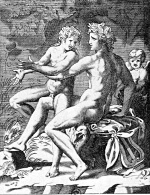Template:Portal:History:Ancient Greece: Difference between revisions
From BoyWiki
No edit summary |
Better picture for Caraglio's "Apollo and Hyacinth" |
||
| Line 3: | Line 3: | ||
|align="left" style="font-size:12pt; font-weight:bold; padding:5px"| [[Ancient Greece]] | |align="left" style="font-size:12pt; font-weight:bold; padding:5px"| [[Ancient Greece]] | ||
|- | |- | ||
|[[File: | |[[File:CARAGLIO Giovanni Jacopo 1530c Apollo e Giacinto 802x1042.jpg|thumb|right|150 px|[[Apollo]] and [[Hyacinth (mythology)|Hyacinth]]]] | ||
* [[Ganymede]] is the young, beautiful boy that became one of Zeus' lovers. One source of the myth says that Zeus fell in love with Ganymede when he spotted him herding his flock on Mount Ida near Troy in Phrygia. | * [[Ganymede]] is the young, beautiful boy that became one of Zeus' lovers. One source of the myth says that Zeus fell in love with Ganymede when he spotted him herding his flock on Mount Ida near Troy in Phrygia. | ||
Revision as of 21:17, 20 September 2014
| Ancient Greece |

|